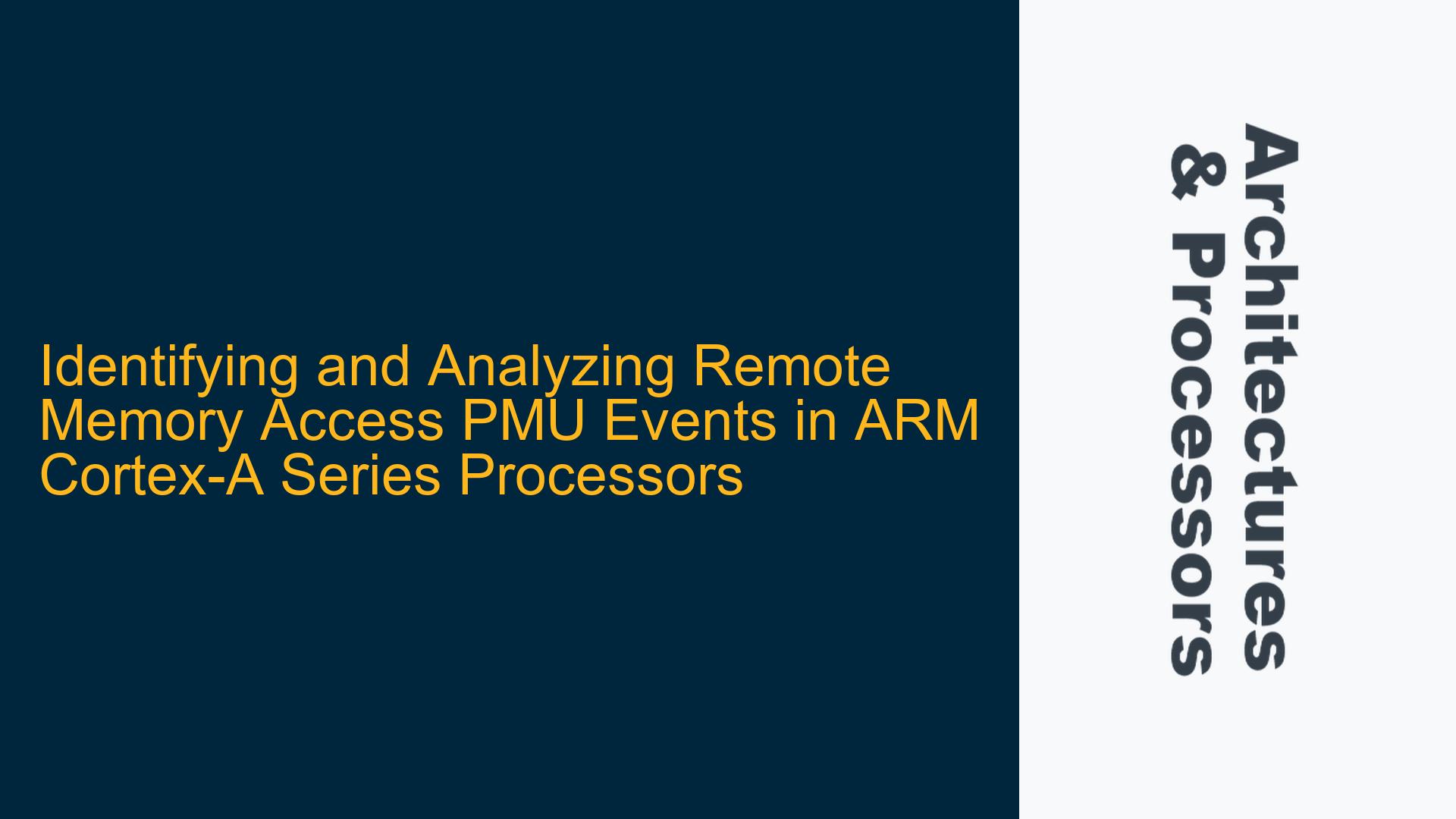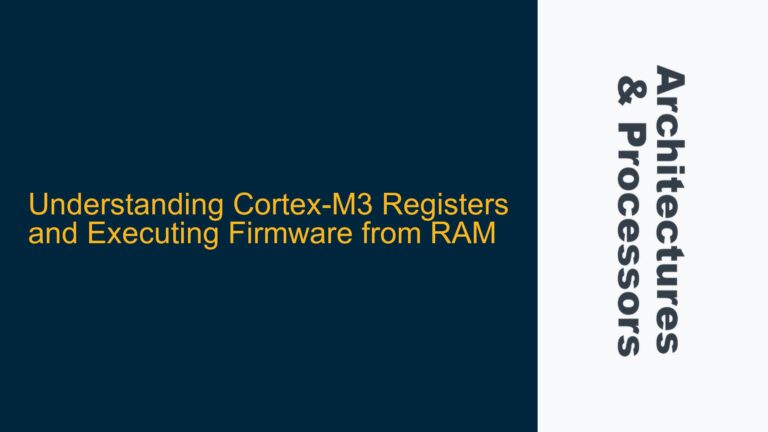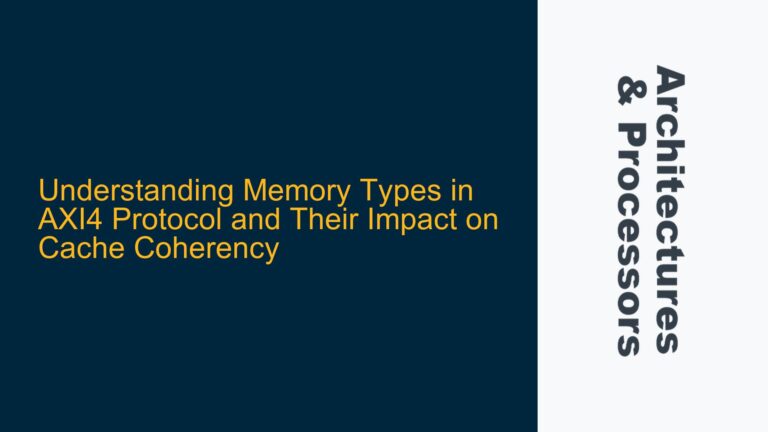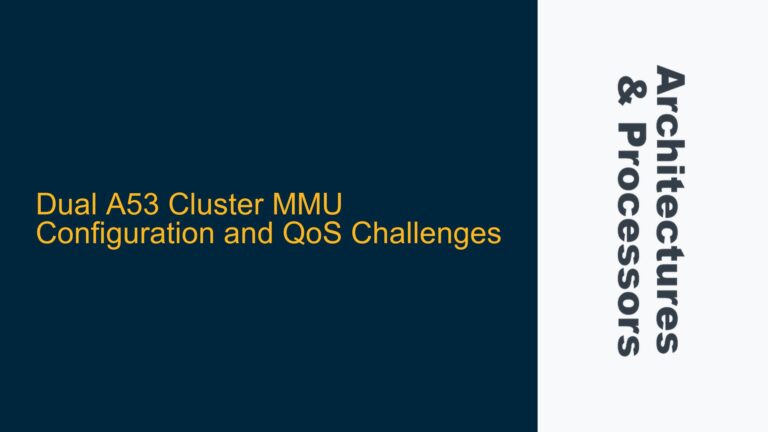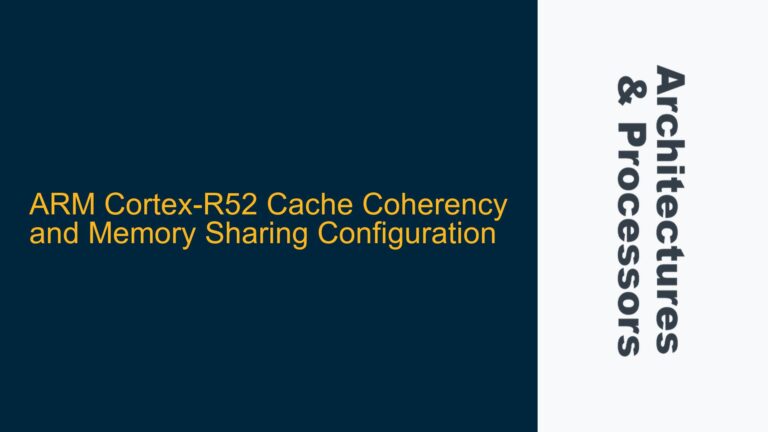ARM Cortex-A Series PMU Events for Remote Memory Access and Snooping
The ARM Cortex-A series processors, particularly those based on the ARMv8-A architecture, incorporate Performance Monitoring Units (PMUs) that provide detailed insights into system behavior, including memory access patterns and cache coherency operations. One critical aspect of performance analysis in multi-core and multi-cluster systems is understanding how remote memory accesses and cache snooping operations are handled. These operations are essential for maintaining cache coherency across cores and clusters, but they can also introduce latency and performance bottlenecks if not properly managed.
The ARM Architecture Reference Manual for A-profile architectures defines a set of microarchitectural events that can be monitored using the PMU. These events include specific counters for remote memory accesses, snoop hits, and other related operations. For example, events such as REMOTE_ACCESS, REMOTE_ACCESS_RD, DSNP_HIT_RD, DSNP_HIT_NEAR_RD, DSNP_HIT_FAR_RD, and DSNP_HIT_REMOTE_RD provide granular visibility into how the processor handles memory requests that involve remote caches or memory subsystems. These events are crucial for diagnosing performance issues related to inter-core or inter-cluster communication, as well as for optimizing software to minimize unnecessary remote accesses.
However, the availability and exact behavior of these events can vary depending on the specific implementation of the ARM Cortex-A processor. Some events may not be supported on all cores or clusters, and their interpretation may require careful analysis of the system’s memory hierarchy and cache coherency protocol. For instance, the DSNP_HIT_REMOTE_RD event indicates a snoop hit in a remote cache, which implies that the requested data was found in another core’s cache rather than in local memory or caches. This event can be used to identify situations where data is frequently shared between cores, potentially leading to increased latency due to inter-core communication.
Understanding these PMU events requires a deep knowledge of the ARM architecture, including the cache coherency mechanisms such as the AMBA ACE (AXI Coherency Extensions) protocol and the role of the snoop control unit (SCU) in managing cache coherency across multiple cores. Additionally, the interpretation of these events must take into account the specific configuration of the system, such as the number of cores, the organization of the cache hierarchy, and the topology of the memory subsystem.
Memory Hierarchy and Cache Coherency Implications for PMU Event Interpretation
The ARM Cortex-A series processors employ a sophisticated memory hierarchy that includes multiple levels of caches (L1, L2, and sometimes L3) and a distributed memory subsystem. In multi-core and multi-cluster systems, maintaining cache coherency across these hierarchies is a complex task that involves frequent communication between cores and clusters. This communication is facilitated by the cache coherency protocol, which ensures that all cores have a consistent view of memory.
When a core performs a memory access, it first checks its local caches (L1 and L2). If the data is not found locally, the request is forwarded to other cores or clusters, potentially resulting in a remote memory access or a snoop operation. These operations are tracked by the PMU through specific events such as REMOTE_ACCESS_RD and DSNP_HIT_REMOTE_RD. The REMOTE_ACCESS_RD event indicates that a read operation was serviced by a remote device, which could be another core’s cache or a remote memory controller. The DSNP_HIT_REMOTE_RD event, on the other hand, indicates that the requested data was found in a remote cache as a result of a snoop operation.
The interpretation of these events must consider the topology of the system. For example, in a system with multiple clusters, a remote access could refer to a different cluster within the same chip or a completely separate chip in a multi-chip module (MCM) configuration. The latency and performance impact of these accesses can vary significantly depending on the distance between the requesting core and the remote device. Additionally, the behavior of these events can be influenced by the configuration of the cache coherency protocol, such as whether the system uses a directory-based or snoop-based coherency mechanism.
Another important consideration is the role of the snoop control unit (SCU) in managing cache coherency. The SCU is responsible for coordinating snoop requests between cores and ensuring that all caches are kept consistent. The PMU events related to snooping, such as DSNP_HIT_RD and DSNP_HIT_REMOTE_RD, provide insights into how effectively the SCU is managing these operations. High counts of these events may indicate frequent cache misses or inefficient data sharing between cores, which could be a target for optimization.
Practical Steps for Analyzing and Optimizing Remote Memory Access Patterns
To effectively analyze and optimize remote memory access patterns using the PMU events described above, a systematic approach is required. The first step is to identify the relevant PMU events for the specific ARM Cortex-A processor being used. This involves consulting the ARM Architecture Reference Manual for the A-profile architecture and verifying which events are supported by the hardware. Once the relevant events have been identified, they can be configured and enabled using the PMU registers.
The next step is to collect performance data during the execution of the target workload. This can be done using tools such as perf on Linux or custom profiling software that interfaces directly with the PMU. The collected data should include counts of the relevant PMU events, as well as additional context such as the core and cluster IDs, to enable detailed analysis of the memory access patterns.
Once the data has been collected, it can be analyzed to identify performance bottlenecks related to remote memory accesses. For example, high counts of the REMOTE_ACCESS_RD event may indicate that a significant portion of memory accesses are being serviced by remote devices, which could lead to increased latency. Similarly, high counts of the DSNP_HIT_REMOTE_RD event may indicate frequent data sharing between cores, which could be optimized by improving data locality or reducing unnecessary sharing.
Based on the analysis, specific optimizations can be applied to the software or system configuration. For example, data structures can be reorganized to improve cache locality, or thread affinity can be adjusted to minimize inter-core communication. Additionally, the system’s memory hierarchy and cache coherency configuration can be tuned to reduce the impact of remote accesses, such as by increasing the size of local caches or optimizing the placement of frequently accessed data.
Finally, it is important to validate the effectiveness of the optimizations by repeating the performance analysis and comparing the results with the baseline data. This iterative process of analysis, optimization, and validation is key to achieving optimal performance in multi-core and multi-cluster ARM Cortex-A systems.
In conclusion, the PMU events related to remote memory accesses and snooping provide valuable insights into the behavior of ARM Cortex-A series processors in multi-core and multi-cluster systems. By understanding and leveraging these events, developers can diagnose performance bottlenecks, optimize software and system configurations, and achieve significant improvements in system performance and efficiency.
